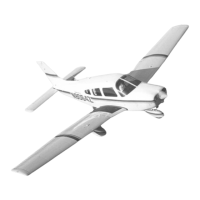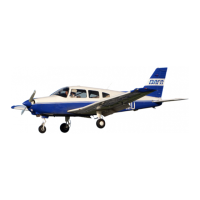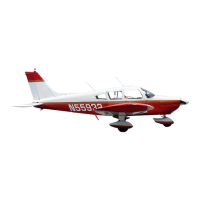PIPER AIRCRAFT, INC.
PA-28-161, WARRIOR III
MAINTENANCE MANUAL
PAGE 3
Nov 30/06
1J21
20-20-00
7. Paint System Compatibility
Before applying new paint, find what type finish was used previously. Refer to the Piper parts catalog for
correct paint number and color.
Identify paint finishes by applying engine oil to a small surface area. Old nitrocellulose finishes will soften
in a few minutes. Acrylics, urethanes, and epoxy finishes show no effects.
If not identified, wipe down a small area with rag wet with methyl ethyl ketone. MEK picks up pigments
from acrylic finishes, but not from epoxy or cured urethane coatings. Wipe surface, do not rub. Heavy
rubbing picks up epoxy and urethane pigments from coatings not fully cured.
The use of different types of paint, with several coatings, make repair of damaged and deteriorated
areas difficult. Paint finishes are not always compatible. The following are general rules for compatibility
and are not necessarily listed in order of importance.
A. Old type zinc chromate primer may be used directly for touch-up of bare metal surfaces and on
interior finishes. It may be overcoated with wash primers if in good condition. Acrylic lacquer finishes
will not adhere to this material.
B. Modified zinc chromate primer will not adhere to bare metal. Never use it over a dried film of acrylic
nitrocellulose lacquer.
C. Nitrocellulose coatings will adhere to acrylic finishes, but reverse is not true. Do not use acrylic
nitrocellulose lacquers over old nitrocellulose finishes.
D. Acrylic nitrocellulose lacquers will not adhere to nitrocellulose and epoxy finishes and to bare metal.
For best results, apply lacquers over fresh, successive coatings of wash primer and modified zinc
chromate. They also adhere to freshly applied epoxy coatings (dried less than 6 hours).
E. Epoxy topcoats adhere to all paint systems in good condition. Use epoxy for general touch touch-
up, including touch-up of defects in baked enamel coatings.
F. Old wash primer coats may be overcoated directly with epoxy finishes. Apply a new second coat of
wash primer if an acrylic finish is to be applied.
G. Old acrylic finishes may be refinished with new acrylic provided old coating is thoroughly softened
using acrylic nitrocellulose thinner before paint touch-up.
H. Repair damage to epoxy finishes by using more epoxy. Neither lacquer finish will stick to epoxy
surfaces. In some instances, air drying enamels may be used for touch-up of epoxy coatings if
edges of damaged areas are roughened with abrasive paper.
8. Common Paint Troubles
A. Poor Adhesion - Paint properly applied to correctly pretreated surfaces will adhere satisfactorily.
When thoroughly dry, paint must not be easily removed. Poor adhesion can result from:
(1) Inadequate cleaning and pretreatment.
(2) Inadequate stirring of paint or primer.
(3) Coating at incorrect time intervals.
(4) Application under adverse conditions.
(5) Bad application.
B. Spray Dust - Spray dust caused by atomized particles drying before reaching surface being painted
fail to flow as a continuous film. Usual causes are incorrect air pressure or distance gun is held from
work.

